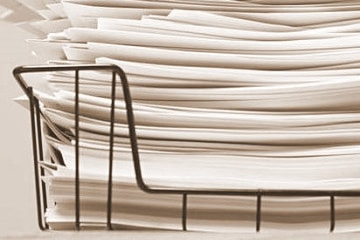|
It all depends on what kind of paperwork you are looking at and how you go about the task at hand. A huge pile of mixed publications, mail, advertisements, flyers and notes will naturally take more time to sort out than a simple backlog of the more administrative kind of papers that simply needs to be taken care of, filed and archived. In this instance, let’s look these administrative papers. Assuming you have taken care of the activities associated with paperwork in front of you (paying bills, following up on appointments, etc.), what remains is filing and archiving. Filing is not all that difficult: the main issue is usually to find a way to group things into manageable categories that are small enough to stay easily researchable while avoiding too much structure surrounding the actual papers. It’s structure and content that need to find a balance that works for you. Here’s an example: let’s say you have a number of home utilities suppliers for water, gas, electricity, internet & phone, garden refuse removal, etc. In the first instance, it makes sense to lump all suppliers into one category, of course. You’ll start out putting all the related papers into one folder, binder, or hanging file, and not even in any particular order. After a while, however, you may find it hard to locate particular papers. At this point in time, it’s imperative to take all those papers and sort them into different piles for each supplier. Whenever I come to this stage, I usually end up with a couple of suppliers that have a lot of paperwork (especially if you receive paper bills with lots of attachments and detailed marketing materials), while others remain easy to deal with because after the initial contract all the correspondence is electronic in nature. What to do then? Simple: create specific subcategories (with their folder, binder, hanging file) but – and this is important! – keep the small piles in the original category, maybe separated by riders or post-it stickers. You can see what I did here: we only created a new sub-category where it was necessary. If we had created subfolders for each supplier with one piece of paper in each of them, you’d be burdened with unnecessary structure for no good reason. This approach keeps structure at a minimum, and ease of use at a maximum. The ‘drawback’ is that you may need to reassess your structure on occasion, but to be honest, that tends not to happen all that often. Reviewing structure and content of your files is advantageous for another reason: papers you have filed at some point may (and will) become unnecessary sooner rather than later! Let’s look at that suppliers file once again: each time you receive a new electricity bill, it would state how much you still owe from the last bill (ideally: nothing), which technically makes the previous bill unnecessary. Unless there are other considerations (legal obligations, proof for taxes or residence, etc.) you could potentially only keep the last one and discard the previous one. This said, filing is not just about putting things INTO a filing system, but also clearing OUT things that are no longer relevant, thereby keeping the filing system easy to use and making it a quick job to find what you are looking for. It’s important to treat filing as a living thing rather than a repository of the past and spend the occasional half hour taking care of it. Tip of the week: make sure to put at least one instance of filing into your home diary every month. That’s filing, NOT paying bills or taking care of business: just filing and cleaning out your files. You’ll see that things will become a lot easier to manage and less off-putting than ever! If you have enjoyed reading this, you may find these other articles interesting: Comments are closed.
|
Ask the ClutterMeisterIdeas to help clear away the mess in your homes and in your minds.
Feel free to share any of my posts, but please put in a backlink to the original blog post. Thank you. The author
Hi, my name is Tilo Flache. My mission: help clients declutter mind and space.
This blog contains pointers for your journey towards a happier living experience. Archives
November 2023
|



 RSS Feed
RSS Feed




